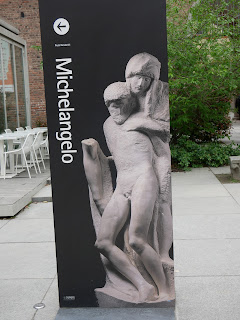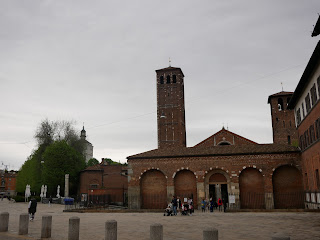A two-tour day is a challenge, but since our time was limited in Milan, I booked a free walking tour of the city for the same afternoon of our tour of The Last Supper.
We took the City Storytelling Experience: Art, History, and Myths Tour through Guru Walks. Doing a quick google search to find the link for the tour we took, brought up many other options. I know a reason I chose this one was because it was in the afternoon, allowing us time to eat lunch and explore Milan before the 3 PM tour.
The tour packed a lot of information into two and a half hours. It was probably one of the most intense free walking tours I have ever taken. At the start of the tour, our guide, Serena, warned us there was little opportunity to take pictures. There were only seven scheduled for the tour. One of the seven brought a friend. They were both turned away -- a rarity on a free tour that is dependent on tips. Even though two people had not yet shown up, she still wanted the group to be small. The other couple spoke English as a second language. They were carrying serious cameras. Fortunately they still had few days left in Milan to return and take decent pictures.
As per my usual, I had my notebook out taking notes, while also taking pictures, asking questions, and participating in the discussion. Serena offered to send me her notes after the tour, which she did. She is a kindred spirit who does the same when she travels.
We met at the Basilica de Sant'Ambroggio. Thank goodness for Google Maps as they guided us to the start.
In the 6th century BC Celtics were looking for a boar. They were told when they find it, build the temple like Stonehenge in that spot. That became the Foundation of Mediolanum. It is a combination of the words medio (half length) and lanum (wool). The combination of he geographical position and fertile land means Milan became second only to Rome. In 286 Diocletian divided the Roman Empire into four sections, with Milan as the capital until 402 AD. During this time, Constantine legalized Christianity in 313 AD.
Ambrose was the governor of Milan until he became the bishop in 274 AD. He was chosen because he was half German and Half Italian, therefore making both groups happy.
In those days, churches were outside of the city walls. Martyrs were murdered and buried by the church. People gathered in this courtyard until they were baptized. The church was built with Greek mythological symbols, including Pegasus and a Centaur.
During the week, a market took place in this courtyard.
There was a competition to figure out who would build the best tower, which is why one is taller than the other.
Serena pointed to this lintel of David between the two lions.
We entered the basilica. We quickly learned the correct answer to just about any question is Ambroise. Keep that in mind.
The Basilica di Sant'Ambogio is one of the oldest churches still in use. It is full of rich history and interesting stories. The courtyard is laid out like a chessboard with 7 squares. December 7th is the feast day of St. Ambroise (and a major holiday in Milan). The snake is a symbol of this church.
Some highlights of the basilica:
 |
| Mosaic of Ambroise: He was remembered as a simple ma |
 |
| The crypt of St. Ambroise |
 |
| A hallway |
 |
| The golden altar was added in the 4th century |
 |
 |
| Moses's snake was a wedding gift Look at it with faith and you will be healed The second coming is happening when he comes to life and starts moving down the column |
 |
| A rare statue of someone smiling |
The Devils Column marks the spot where a battle between Ambrose and the Devil took place. It is considered the portal to hell. I gave it a wide berth.
These are called "stumbling stones." They are placed in front of the homes where Jews lived before they were taken during the Holocaust. The movement was started by Lilliana Segre (born in 1930, still alive). She was born in a wealthy family. In 1938 when the racial laws started she was hidden in the countryside with a family for five years. In December 1944 her family tried to escape and cross the border, but the Swiss soldiers sent them back. They were deported on the first train to Auschwitz on January 1, 1945. They survived ad came back. Lilliana did not talk about her experiences until she became a grandmother. In 1992 She started this movement of commemorating those victims. In 2019 she was nominated a senator for life. There is a connection between her and the movie Jojo Rabbit.
This is Santa Maria della Grazie Church's Frog Courtyard. I'm all turned around. According to our guide, this is where The Last Supper is located. Where we began our day. The church is designed by Bramante (a famous architect. It took 200 years to decorate the inside. Listed as a UNESCO World Heritage site in 1980. Sforza (successors of the Visconti) invited Leonardo da Vinci to decorate the monastery.
On our way here we passed a green home she told us to remember, that she would tell us about it later. It is hard to organize a tour when the sites of interest are not in the order of the story! The green building was the location of Leonardo's vineyard.
 |
| The holes here are for the scaffolding that was needed to build it. It is something Don has always wondered. |
 |
| Florence has David. Milan has his Pieta. |
 |
| We went back at night to see the Arch of Triumph/ Peace up close. |
Merchant Square
Next to the Duomo is the Galleria Vittorio Emanuele II designed to celebrate the unification of Italy. It many symbols on the inside representing the different parts of Italy (Milan, Turin, Florence, and Rome), value (agriculture, art, science, and industry), continents. It was built with bad luck. Three years before the inauguration a hailstorm destroyed all the glass. The night before the dedication ceremony on the lead architect died. The king said he was not going to come, which may have contributed to the death of the architect. Today it is filled with swanky shops.
 |
| Turn here three times (with one push) and you'll have good luck. I saw many try. I did. Don didn't. I picture a ballerina effortlessly achieving perfection. |


























No comments:
Post a Comment